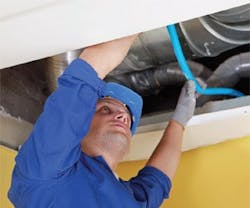Better Ventilation Could Save Billions, Studies Say
Basic remedial measures to increase ventilation could provide billions of dollars in economic benefits in the U.S., according to a pair of recent studies by the Lawrence Berkeley National Laboratory.
One study, published in Indoor Air, uses the existing level of IEQ in U.S. office buildings as a baseline to estimate the impact of four IEQ changes:
- Increasing ventilation rates: Researchers boosted outdoor air ventilation rates above 10-15 liters per second per person. ASHRAE recommends 8.3 liters per second, while 10 liters per second is common in other countries.
- Adding outdoor air economizers and controls: These systems increase the outdoor air supply when the additional ventilation will reduce the need for air conditioning.
- Avoiding office overheating: Adjusting thermostat setpoints and other measures eliminated winter indoor temperatures greater than 73 degrees F.
- Reducing dampness and mold: Researchers improved maintenance to prevent and fix water leaks, change design and construction practices, and improve humidity control in hot and humid climates.
The improvements produced small increases in work performance, fewer absences, and reduced healthcare costs. For instance, the study found that preventing overheating would eliminate 7.7 million weekly Sick Building Syndrome symptoms in the winter, improve performance by 0.2%, and reduce thermal discomfort by 12% among 40.4 million workers.
The other study, which appeared in Building and Environment, examined the potential effects of raising outdoor ventilation rates above the ASHRAE standard. For example, a 25% increase (from 8 liters per second to 10) would reduce Sick Building Syndrome symptoms in 500,000 workers, eliminate 9.4 million days of short-term absence, and boost work performance by an average of 0.3%.
However, a 90% increase to 15 liters per second resulted in the prevention of SBS symptoms in 1.4 million workers, 30 million fewer days of short-term absence, and a 0.9% boost in performance.
Researchers are still unsure of the magnitude to which ventilation affects health, performance, and absence, but both studies conclude that the potential benefits in productivity and long-term savings outweigh the additional energy cost.
